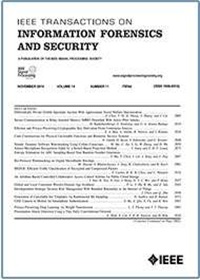Uncoordinated Syntactic Privacy: A New Composable Metric for Multiple, Independent Data Publishing
IF 6.3
1区 计算机科学
Q1 COMPUTER SCIENCE, THEORY & METHODS
IEEE Transactions on Information Forensics and Security
Pub Date : 2025-03-14
DOI:10.1109/TIFS.2025.3551645
引用次数: 0
Abstract
A privacy model is a privacy condition, dependent on a parameter, that guarantees an upper bound on the risk of reidentification disclosure and maybe also on the risk of attribute disclosure by an adversary. A privacy model is composable if the privacy guarantees of the model are preserved, possibly to a limited extent, after repeated independent application of the privacy model. From the opposite perspective, a privacy model is not composable if multiple independent data releases, each of them satisfying the requirements of the privacy model, may result in a privacy breach. Current privacy models are broadly classified into syntactic ones (such as k-anonymity and l-diversity) and semantic ones, which essentially refer to非协调语法隐私:用于多个独立数据发布的可组合新指标
隐私模型是一种依赖于参数的隐私条件,它保证了再标识披露风险的上限,也可能是攻击者披露属性风险的上限。如果在多次独立应用隐私模型后,该模型的隐私保证被保留(可能在有限程度上保留),则该隐私模型是可组合的。从相反的角度来看,如果多个独立的数据发布(每个数据都满足隐私模型的要求)可能导致隐私泄露,那么隐私模型是不可组合的。目前的隐私模型大致分为句法模型(如k-匿名和l-多样性)和语义模型,本质上是指$\varepsilon $ -差分隐私(e-DP)及其变体。虽然e-DP及其变体提供了强大的可组合性属性,但语法概念是不可组合的,除非数据发布是由使用m-不变性和$\tau $ -安全等专门概念的单个集中式数据持有者执行的。在这项工作中,我们提出了m-非协调句法隐私(m-USP),这是第一个具有可组合性属性的句法概念,用于独立发布非分离数据,换句话说,没有集中的数据持有者。理论结果得到了正式证明,实验结果表明,与易受属性披露影响的非组合方法相比,个体的风险没有显著增加。在大多数情况下,由额外保护引起的效用退化小于5% and decreases as the value of m increases.
本文章由计算机程序翻译,如有差异,请以英文原文为准。
求助全文
约1分钟内获得全文
求助全文
来源期刊

IEEE Transactions on Information Forensics and Security
工程技术-工程:电子与电气
CiteScore
14.40
自引率
7.40%
发文量
234
审稿时长
6.5 months
期刊介绍:
The IEEE Transactions on Information Forensics and Security covers the sciences, technologies, and applications relating to information forensics, information security, biometrics, surveillance and systems applications that incorporate these features
 求助内容:
求助内容: 应助结果提醒方式:
应助结果提醒方式:


